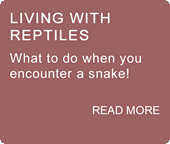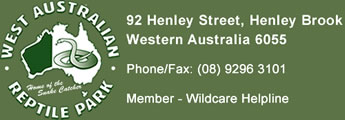Living with Reptiles
Reptiles such as snakes emerge from hibernation on the first warm day at the end of August or early September. Snakes usually avoid contact with humans and only bite when threatened. As long as they have an escape route to retreat to, they will leave you alone.
Snakes are attracted to backyards where prey items such as mice, rats and frogs are abundant as these are their main source of food. They often hide under cover items like corrugated iron, boards, rocks, logs and stumps. Adopting safety measures during this period is a must especially when snakes are likely to be active as they leave hibernation.
Snakes are predators and the rise in their numbers usually associated with the their preys. So to minimise unnecessary encounters the following must be observed.
- Changing the surroundings around the house by keeping the grass short and removing household rubbish, piles of timber and corrugated iron minimises the chance of unexpected encounters with snakes;
- Wearing shoes or boots for protection when walking at night reduces the risk of snakebite as snakes are also active at night during the summer months;
- Using torch when walking at night reduces encounters with snakes;
- Avoiding areas of tall grasses, ponds, dams and undergrowth as snakes may be hiding nearby.
Under no circumstances you are to catch or kill snakes that you encounter in your property. If you find a snake in your property and want it removed contact the Wildcare Helpline on (08) 9474 9055, to refer you to your local Volunteer Reptile Remover.
What to do if bitten by snake
- Stay calm and keep still;
- Do not wash the bitten area;
- Apply direct pressure over the bitten area;
- Apply a firm broad bandage over the bitten area first, then bandage down the limb and continue to bandage up the full length of the limb;
- Do not remove the bandage;
- Immobilise the limb with a splint;
- Do not elevate the limb;
- Call 000 for an ambulance.
For more information on treatment of snakebite download the following factsheet here (St John Ambulance Factsheet).
For further information about snakes and other reptiles visit the Department of Environment and Conservation.






